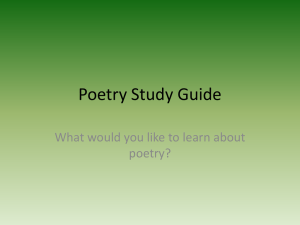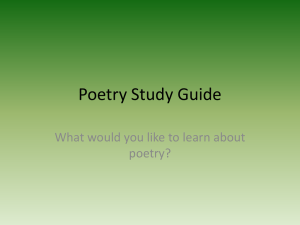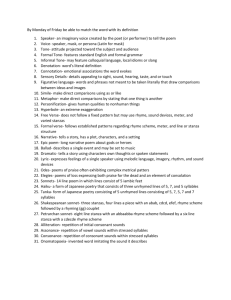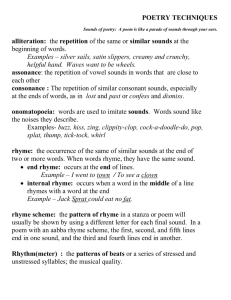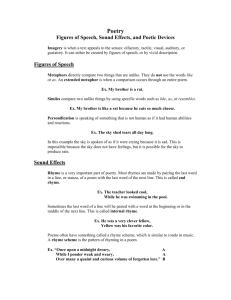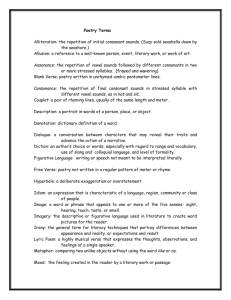Poetic Terminology answers in blanks
advertisement
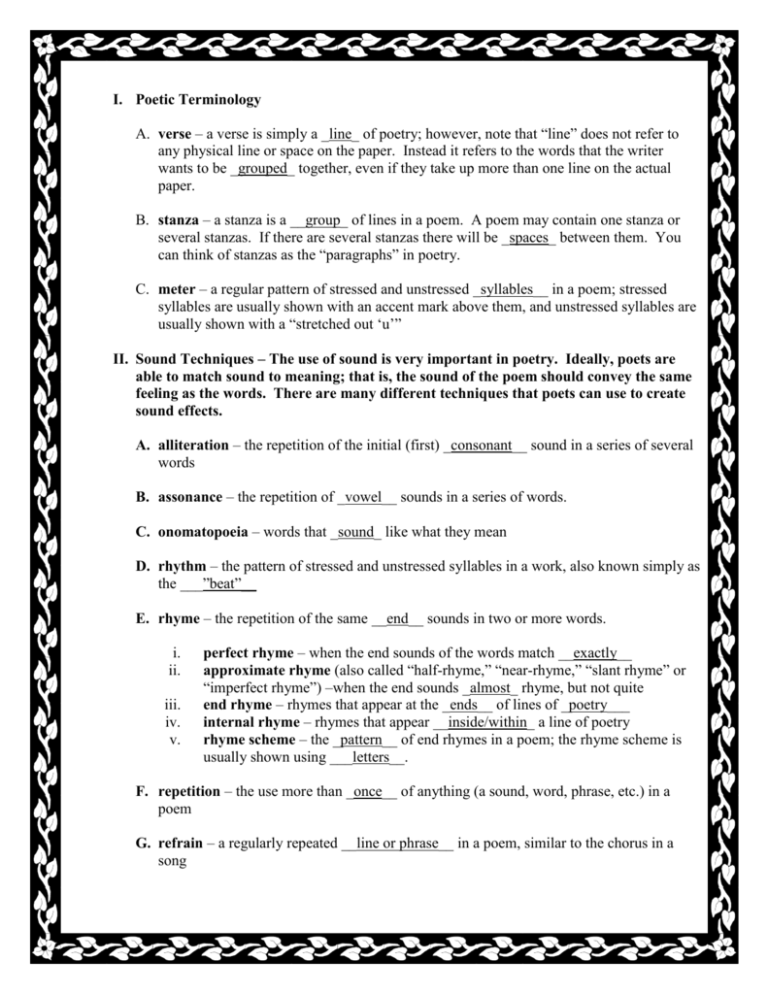
I. Poetic Terminology A. verse – a verse is simply a _line_ of poetry; however, note that “line” does not refer to any physical line or space on the paper. Instead it refers to the words that the writer wants to be _grouped_ together, even if they take up more than one line on the actual paper. B. stanza – a stanza is a __group_ of lines in a poem. A poem may contain one stanza or several stanzas. If there are several stanzas there will be _spaces_ between them. You can think of stanzas as the “paragraphs” in poetry. C. meter – a regular pattern of stressed and unstressed _syllables__ in a poem; stressed syllables are usually shown with an accent mark above them, and unstressed syllables are usually shown with a “stretched out ‘u’” II. Sound Techniques – The use of sound is very important in poetry. Ideally, poets are able to match sound to meaning; that is, the sound of the poem should convey the same feeling as the words. There are many different techniques that poets can use to create sound effects. A. alliteration – the repetition of the initial (first) _consonant__ sound in a series of several words B. assonance – the repetition of _vowel__ sounds in a series of words. C. onomatopoeia – words that _sound_ like what they mean D. rhythm – the pattern of stressed and unstressed syllables in a work, also known simply as the ___”beat”__ E. rhyme – the repetition of the same __end__ sounds in two or more words. i. ii. iii. iv. v. perfect rhyme – when the end sounds of the words match __exactly__ approximate rhyme (also called “half-rhyme,” “near-rhyme,” “slant rhyme” or “imperfect rhyme”) –when the end sounds _almost_ rhyme, but not quite end rhyme – rhymes that appear at the _ends__ of lines of _poetry___ internal rhyme – rhymes that appear __inside/within_ a line of poetry rhyme scheme – the _pattern__ of end rhymes in a poem; the rhyme scheme is usually shown using ___letters__. F. repetition – the use more than _once__ of anything (a sound, word, phrase, etc.) in a poem G. refrain – a regularly repeated __line or phrase__ in a poem, similar to the chorus in a song Figures of Speech (Figurative Language) – The literal meaning of a word is its exact, true, III. “dictionary” meaning. Figurative language is language that uses words in an imaginative or non-literal way in order to create specific effects or to make writing more vivid and interesting. There are many different figures of speech. Here are a few of the most common ones: A. simile – a comparison using ___like_____ or ____as______ B. metaphor – a ____direct______ comparison (without the use of “like” or “as”) C. personification – attributing _____human_______ characteristics to nonhumans D. alliteration – the _____repetition___ of the initial (first) consonant sound in a ___series___ of words. E. assonance – the repetition of __vowel__ sounds in a series of words. (The vowel does not need to be the first letter or sound of the word.) F. hyperbole – the use of ___exaggeration__ for humor or effect G. onomatopoeia – words that create the __sound_ of their own meaning; words that create __sound__ effects. H. irony – the use of words to convey the __opposite__ of their literal meaning; incongruity between what might be expected and what actually occurs I. oxymoron – the combination of seemingly _contradictory__ terms to create a particular feeling or effect J. symbol/symbolism – something which stands for or _represents__ something else K. allusion – a ___reference___ in one work of art to something else (outside of the work itself) considered to be well known. L. imagery – language that appeals to one or more of the senses; language that creates vivid mental __pictures__ . M. ambiguity – something that can be interpreted to mean __several___ different things at the same __time__. N. economy – the ability to put the greatest amount of __meaning__ into the __fewest__ words possible.
